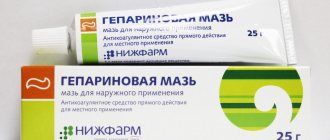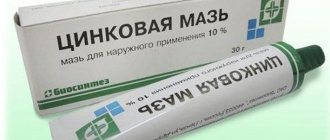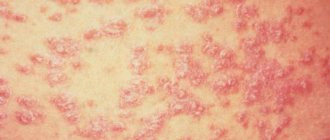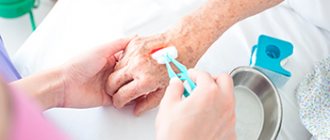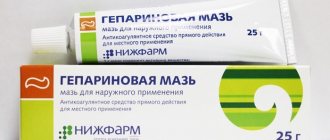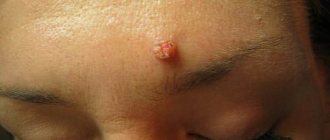Scientifically, “bumps” from injections are called post-injection infiltrates of the buttocks. “They are lumps that appear some time after an intramuscular injection,” says the head of the outpatient surgery department at one of the medical clinics in Moscow. “They are a pathological response of the body to the administration of a drug, regardless of its type.”
There are several types of “bumps” on the buttocks after an injection. “The first option is an infiltrate, that is, a local reaction, which is characterized by a tissue response at the injection site - edema,” explains the surgeon, graduate student of the Faculty of Internal Medicine, Department of Surgery, Department of Surgical Endocrinology, State Budgetary Healthcare Institution MONIKI named after. M. F. Vladimirsky. — The second option is a hematoma. It appears from hemorrhage of a damaged vessel after injection; unfortunately, it is impossible to predict this in advance.”
The third option (and the most dangerous) is an abscess. “Abscesses are very painful formations with purulent contents and a vivid clinical picture; they can only be treated surgically,” adds the doctor.
In fact, “bumps” are a local reaction of the body to a puncture and intramuscular injection of the drug. If left untreated, the infiltrates can become abscesses, which pose a serious health threat. “In most cases, in relatively healthy people they go away within a week, but there are exceptions,” the doctor notes.
How dangerous is this?
Bumps, bruises, redness and other formations on the buttocks after treatment are called post-injection infiltrates. In most cases, they do not pose a health hazard and resolve on their own after some time - from several days to weeks. Sometimes lumps remain under the skin for two months or more - it is quite difficult to resolve old infiltrates, so most often they are removed surgically.
If a lump or redness has formed on a child’s buttock, it is better to consult a doctor, since the child’s body is more susceptible to complications and pathological processes.
You need to pay special attention to injection sites if they cause serious discomfort.
Alarming symptoms include pain, local and general fever, and deterioration in general well-being. They indicate that an inflammatory process is occurring deep in the tissues, which requires consultation with a doctor.
Indications for use of Levomekol ointment
Since Levomekol ointment has an antibacterial effect, and at the same time stimulates the restoration of tissue structure, the drug is indicated for the following diseases:
- infection of wounds with pathogenic microflora, ulcers and purulent abscesses on the epidermis;
- burns (mostly 2nd and 3rd degree);
- violation of tissue integrity due to injuries;
- necrotic processes;
- weeping and dry eczema;
- calluses;
- trophic ulcers;
- frostbite of the extremities (superficial layers of the skin);
- pimples, acne, carbuncles, boils;
- otitis and sinusitis (including with purulent discharge);
- treatment of sutures after surgery
- bedsores;
- haemorrhoids.
Levomekol ointment can be used for children
"Levomekol" can be used for children from 1 year. But before this, it is imperative to consult a pediatrician.
Why do lumps appear after an injection?
Lumps (infiltrates) on the buttocks can appear for various reasons, regardless of whether the injection was given by a nurse in the hospital or by one of the family members. There are general rules for administering intramuscular injections, but even if they are followed, a formation may appear on the buttock. The factors that cause their appearance include:
- incorrect choice of syringe (needle too large or small);
- characteristics of the drug - thick and oily liquids most often cause side effects;
- insufficiently deep administration of drugs;
- tension in the gluteal muscles;
- low temperature of the liquid in the ampoule;
- needle getting into nerve endings or blood vessels (bruises appear under the skin);
- allergic reactions to drugs.
The most dangerous are considered to be lumps that formed as a result of violation of the rules of hygiene and asepsis during treatment with intramuscular injections - abscesses. In such cases, an infection enters the tissue, which can lead to unpleasant consequences. It is almost impossible to get rid of them at home, so the patient should go to a medical facility.
Levomekol or Vishnevsky ointment. What's better?
Let's start with the fact that Vishnevsky ointment and Levomekol, although they are used in similar cases, still have a multidirectional spectrum of action. Thus, Vishnevsky ointment is effective when the wound is in the process of regeneration. Therefore, it cannot be used when the wound is suppurated or severely inflamed. Yes, the drug contains an antiseptic, but its concentration is not enough to provide a bactericidal effect. Moreover, tar and castor oil stimulate blood circulation in the affected area, which worsens the situation.
This is why Vishnevsky’s ointment is not as effective, since Levomekol has higher antibacterial activity due to the presence of an antibiotic in it and accelerates the process of outflow of pus from the wound. Also important are the following distinctive features that determine the superiority of Levomekol ointment:
- no unpleasant odor;
- higher repair characteristics;
- does not provoke irritation in the treatment area;
- when treating boils, Levomekol quickly initiates an abscess and opening of the abscess, followed by wound healing.
But if Vishnevsky ointment helps the patient, then there is little point in changing it.
Abscess symptoms
An abscess is a purulent-inflammatory process that occurs deep in the tissue. It manifests itself in severe pain and other unpleasant sensations (pulsation, burning, itching), enlargement of the lump, and deterioration in general well-being. Sometimes under the skin you can notice purulent masses of a yellow, grayish-white or green hue.
You cannot open or squeeze out an abscess yourself - this can lead to the spread of infection and other complications.
If the abscess breaks out on its own, you can get by with conservative treatment. Otherwise, it is opened surgically, the pus is removed and local medications are prescribed.
In severe cases, patients need to take antibacterial agents and immunostimulants.
Side effects
Levomekol is considered a universal drug that is usually well tolerated by patients. But in case of overdose (if the drug is used for more than a week), allergic skin reactions may occur.
- hyperemia;
- burning;
- itching;
- urticaria;
- dermatitis at the site of application;
- local swelling;
- When using vaginal tampons, candidiasis may occur.
No incompatibility with other medicinal products has been reported. Make sure that the ointment does not get into your eyes, mucous membranes or inside. In case of contact with eyes and mucous membranes, rinse them immediately with running water. If swallowed, the stomach must be rinsed.
Compresses and lotions
Most often, iodine and alcohol, sometimes aloe, cabbage and other means are used to eliminate infiltrates after injections. They have a different mechanism of action - they warm up tissues, relieve inflammation, and promote healing. Several procedures are usually sufficient to obtain the desired effect.
- Iodine mesh
. An iodine mesh is the most common way to treat infiltrates. Iodine is applied to the affected area using a cotton swab several times a day. - Alcohol compresses
. Alcohol is diluted with water in proportions of 2 to 1, a piece of natural fabric is moistened in it, applied to the sore spot for 2-3 hours, and covered with cellophane on top. - Aloe and cabbage
. Lightly beat a fleshy piece of aloe or cabbage leaf, apply it to the seal, put a bandage on top and leave for 1.5-2 hours.
Old infiltrates (over six months old) usually do not resolve on their own or with the help of compresses. They are a capsule that is overgrown with tissue, so drugs do not penetrate inside. If such bumps cause inconvenience, they are removed surgically.
Dough from old infiltrates
What resolves bumps from injections? If this issue is still relevant for you, you can use grandma’s method, which will help get rid of even the most stubborn seals.
Sometimes the redness goes away, but the hardness remains for a long time. If a person wants to get rid of it as quickly as possible, without waiting for it to resolve on its own, then you can try the following method, which is quite original. Dough is made from butter, one chicken egg, a small amount of wheat flour and honey. A small piece is applied to the skin, and the rest of the mass is stored in the refrigerator and used next time.
Medications
To eliminate lumps and lumps after injections, ointments and gels are used, which have a warming, antiseptic and anti-inflammatory effect. Most of them are considered safe, but require caution when used.
Before smearing the affected areas, you should carefully read the instructions for use, the list of contraindications and side effects. It is strictly not recommended to exceed the dosage, and if the patient still has any questions, it is better to consult a doctor.
Vishnevsky ointment
Balsamic liniment, or Vishnevsky ointment, is an inexpensive and accessible product based on castor oil, birch tar and xeroform. It relieves inflammatory processes, destroys pathogenic microorganisms and promotes tissue regeneration.
Widely used for infiltrates and purulent-inflammatory processes, as it has the ability to draw out pus. The product is applied to a folded bandage, applied to the sore spot for 4-5 hours, after which the compress is removed. The disadvantages of using ointment are the unpleasant odor and the ability to stain clothes.
Dimexide
A drug based on dimethyl sulfoxide, which is widely used in medicine for joint and muscle pain, bruises, swelling, inflammatory processes, etc. It has an analgesic effect, relieves inflammation, destroys pathogenic microorganisms and promotes maximum penetration of drugs into the affected area. Dimexide is considered a safe product, but caution should be exercised when using it.
Warming up the bumps on the buttocks in any way is strictly prohibited - this will not bring relief, but will only aggravate the condition and may contribute to inflammation.
The product is available in the form of a liquid for external use or a gel. The gel is used as indicated in the instructions, and the liquid is diluted with water in proportions of 1 to 10, moistened with the resulting solution on natural fabric and applied to the sore spot.
The compress is insulated from above and kept for 30 minutes; the procedure can be carried out 2 times a day. The main contraindications to the use of Dimexide are childhood, pregnancy, and individual intolerance to the components.
Heparin ointment
Heparin is a substance with an antithrombotic effect that promotes the rapid resorption of infiltrates and lumps. It has an anti-inflammatory effect, prevents the formation of blood clots and eliminates discomfort. In addition, the medicine strengthens the vascular walls, prevents their ruptures and the formation of subcutaneous hemorrhages.
The ointment is applied to the affected area in a thin layer, gently rubbed into the skin and left until completely absorbed. You can make compresses from heparin ointment - apply the product to a piece of tissue, apply it to the infiltrate and fix it. The procedure is done 2 times a day until the cones are completely absorbed, but no more than 10 days in a row.
Troxevasin
The product is available in the form of a gel or ointment, the main active ingredient is troxerutin. It is a medicine with a vascular strengthening, anti-inflammatory and anti-edematous effect. Troxevasin promotes the resorption of blood clots and their re-formation, reduces the fragility of blood vessels and increases their elasticity.
The gel is applied to the surface of the skin twice a day, gently rubbed in and left for complete absorption. To enhance the effect, the use of a local remedy can be combined with taking Troxevasin capsules or Ascorutin tablets. The gel can be used for 6-7 days, and if infiltrates and bumps do not disappear, it is better to consult a doctor.
Magnesium sulfate
Magnesia, or magnesium sulfate, is one of the safest drugs that is used to treat infiltrates, inflammatory processes and other pathologies. It promotes muscle relaxation, improves blood circulation and metabolic processes, and promotes tissue regeneration.
Magnesia is available in different forms - most often as a powder for preparing a solution or a ready-to-use liquid. The powder should be dissolved as indicated in the instructions, a piece of gauze should be moistened in the solution, applied to the infiltrate overnight and secured with a band-aid so that it does not slip. Compresses are made from a ready-made magnesia solution in a similar way.
What is Levomekol used for?
Levomekol has a multifaceted therapeutic effect:
- quickly reduces the inflammatory process, prevents its spread to healthy tissues;
- prevents the growth and reproduction of bacterial infectious agents;
- quickly eliminates swelling by normalizing microcirculation;
- ensures delivery of nutrients and biologically active substances, as well as molecular oxygen, to the affected tissues;
- stimulates the regeneration of inflammatory cells of all layers of the epidermis;
- increases immunity at the local level.
The ointment quickly removes all inflammatory processes on the skin
It is worth noting that the presence of purulent discharge and necrotic tissue does not prevent Levomekol ointment from performing its function. The drug can be used to disinfect and accelerate tissue regeneration.
Levomekol, ointment for external use, 40 g, 1 pc.
STADA, Russia
Price from 147₽
There are contraindications. Specialist consultation is required.
How much do medications cost?
Drugs for eliminating post-injection infiltrates may have different prices, depending on the composition, active ingredients and region. In severe cases, patients require complex treatment - topical agents in combination with immunostimulants, antibacterial and vascular-strengthening drugs. The exact cost of medications can be found in regular or online pharmacies.
| A drug | Active substance | Manufacturer | Price, rub |
| Vishnevsky ointment | Birch tar, xeroform, castor oil | Borshchagovsky pharmaceutical plant | 60 |
| Dimexide | Dimethyl sulfoxide | Khimreaktivkomplekt plant, Russian Federation, Galichfarm, Ukraine | 80 |
| Heparin ointment | Heparin sodium | Nizhpharm, Russia | 120 |
| Troxevasin | Troxerutin | Balkanfarma-Razgrad, Bulgaria | 300 |
| Magnesium sulfate | Magnesium sulfate | Most often, pharmacies sell products from Russian and Ukrainian manufacturers. | 37 |
When using medications to treat lumps or lumps formed after intramuscular injections, their characteristics should be taken into account. Each remedy has contraindications and side effects, which should be familiarized with before treatment. Most often, these include childhood, individual intolerance and pregnancy; more details about the method of using medications can be found in the instructions for use.
Contraindications
Like many drugs, Levomekol has contraindications:
- individual intolerance to the components of the medication;
- hypersensitivity of the body;
- fungal infections of the epidermis;
- tendency to allergic reactions;
- psoriasis.
The official instructions for use indicate that in pediatrics the ointment is prescribed starting from 3 years of age. However, many pediatricians, based on the harmlessness of Levomekol ointment, allow its use from infancy.
Bump does not go away after injections
After the injection, a lump formed on the buttock, what should I do? Let's look at the most common, and therefore proven in practice, treatment for lumps on the butt.
- Iodine network
. The simplest and most effective way in which you can help the body resolve bumps from injections. The iodine mesh should be applied with a cotton swab directly to the area with compaction, 1-2 times a day. Iodine has a vasodilating effect, which helps accelerate metabolic processes in the problem area, which means that the solution to the problem will not take long to arrive. - Compress with dimexide
. The drug must be diluted with water according to the instructions. Moisten gauze with it and apply it to the bumps on your butt. Place a plastic bag and a piece of soft cloth on top of the gauze. The compress can be fixed with adhesive tape and left for 40 minutes. Ideally, this procedure should be repeated 2 times a day. - Warming compress based on propolis
. Helps deeply warm the subcutaneous tissue and get rid of post-injection bumps. The compress is extremely simple to make. The area with the seal is lubricated with baby cream, then gauze soaked in propolis tincture is applied on top, then a plastic bag is applied, and a piece of wool or flannel fabric is placed on top of it. The duration of the procedure is 2.5-3 hours. Apply once a day. - Ointment for cones after injections
. Lumps on the buttocks can be treated using heparin or troserutin ointment, or homeopathic ointment "Traumel".
Cabbage leaf with honey
Cabbage leaves are used to treat many diseases. For example, juice or a whole leaf is used for bronchitis, sinusitis, varicose veins, mastitis, as well as for various wounds on the surface of the skin. Cabbage leaf can be applied along with honey or aloe. If you are concerned about the problem being studied and want to find out what resolves bumps from injections, we recommend trying this particular folk method. Usually a medium-sized leaf is taken and beaten with a hammer until juice forms. Next, it is applied to the affected area and secured with an adhesive plaster. This procedure is usually done at night. Sometimes the very next morning there is no trace of hardening left.
If desired, the leaf can be spread on one side with honey. In this case, keep in mind that the honey may leak out and stain your underwear. Therefore, the sheet is fixed as securely as possible, taking into account unforeseen situations.
How to cure a lump after an injection?
So, if after injections the bumps hurt and fester, and the skin in this place blooms wildly, or its sensitivity is impaired, you need to rush to the doctor. Otherwise, the consequences can be unpredictable, from loss of touch in the area of infiltration to general blood poisoning.
The doctor will examine the lesion and, depending on the severity of the case, prescribe either physical therapy or a cleansing operation. Let's look at how to treat bumps after injections on the buttocks using physical therapy:
- Electrophoresis with ledase;
- UFO (ultraviolet irradiation);
- Paraffin or azacerite heating.
Surgical intervention consists of opening and removing subcutaneous suppurations and introducing wound-healing medications. It is clear that resorting to such radical means is the last extreme, but what can you do, although if you follow all the rules given below, then you will not have to treat anything at all.
Analogs
Analogs of Levomekol ointment have a bactericidal and healing effect. But the difference lies in the active ingredient of the drug. So, among the analogues one can name Fugentin, Levosin (additionally has an analgesic effect), Protegentin, Fastin-1, Salicylic-zinc paste.
Synonyms, that is, drugs with the same substance (but in higher concentration) as Levomekol ointment, can be considered Netran and Levomethyl. Substitute medications can only be prescribed by the attending physician.
Prevention of bumps after injections
To avoid the formation of lumps after injections in adults and children, it is necessary to strictly follow the rules for performing intramuscular injections. The drugs are injected strictly into the upper quarter of the buttock, where the safest place is located. Before administration, the skin should be wiped with alcohol, and the ampoule should be rubbed in your hands so that it warms up slightly.
At home, you can only do simple injections - intramuscular injections and vaccinations (for example, against tetanus) are carried out in medical institutions.
Before the procedure, the patient should try to completely relax the muscles - injections into spasmodic areas cause severe discomfort, and after them infiltrates form. It is recommended to use the “cotton” technique in extreme cases, since after such procedures, compactions appear more often. If the course of treatment involves administering the drug for several days in a row, injections are given in each buttock in turn.
Levomekol in the treatment of hemorrhoids
Levomekol ointment can be used as an addition to complex therapy for hemorrhoids during periods of exacerbation. It is recommended to use the ointment in cases where blood is released from the hemorrhoids. Since the drug has an antibacterial effect (wounds can be infected with feces), helps relieve inflammation and neutralize pathogenic bacteria, Levomekol is prescribed for the regeneration of anal tissue.
- it is necessary to wash the perineum and anus with soap and water and dry with a soft towel;
- apply a thin layer of ointment to the anus before going to bed;
- the area of influence from above is covered with a bandage and fixed with an adhesive plaster;
- When treating internal nodes, a tampon is soaked in ointment, which is then inserted into the anus.
Levomekol for hemorrhoids
Duration of therapy is 10 days. Since Levomekol is not a specialized antihemorrhoidal drug, after the inflammation has resolved, the decision to continue therapy and prescribe medications is made only by the attending physician.
Do I need to treat post-injection lumps?
A lump that does not cause discomfort does not need to be treated - to speed up the resorption process, you can draw an iodine mesh or lubricate the area with a special ointment. In addition, it is recommended to carefully observe the place where it formed for several days. The infiltrate should resolve completely or begin to decrease - if it hurts, increases or festeres, you should consult a doctor as soon as possible. Abscesses and other complications that appear after injections require treatment with medications and sometimes surgery.
Preventive measures
Any qualified doctor will confirm that it is easier to prevent disease, pathology and dysfunction than to treat it. To avoid unwanted complications in the form of bruises, bruises and lumps, you must adhere to the following rules:
- It is good to disinfect injection sites
- Use only sterile syringes
- Choose the most suitable place for injections
- Use medications whose expiration date is within the acceptable range
- Inject smoothly
- Remove the needle along the same path along which it was inserted, without unnecessary movements
If you adhere to the recommendations described above, the likelihood that bruises will appear is reduced to almost zero.

